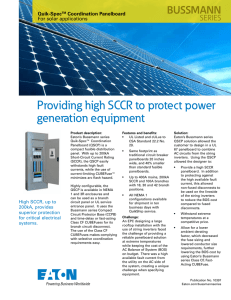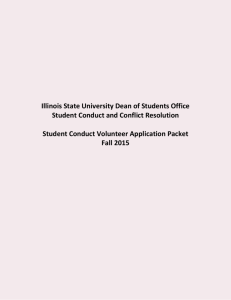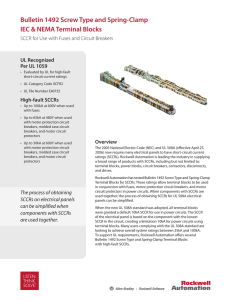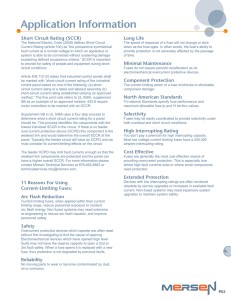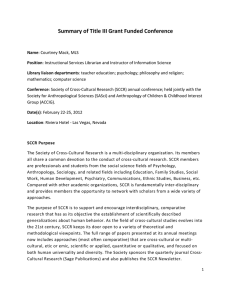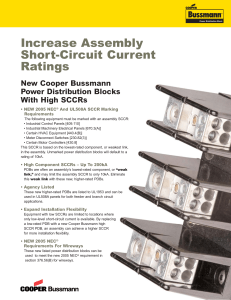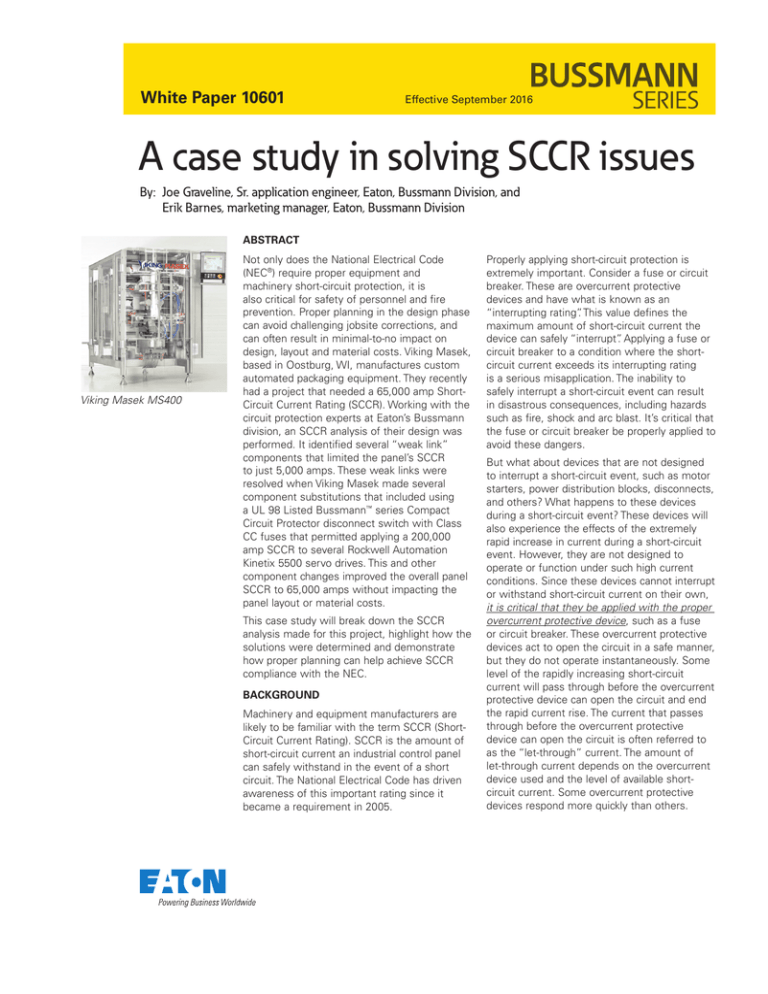
White Paper 10601
Effective September 2016
A case study in solving SCCR issues
By: Joe Graveline, Sr. application engineer, Eaton, Bussmann Division, and
Erik Barnes, marketing manager, Eaton, Bussmann Division
ABSTRACT
Viking Masek MS400
Not only does the National Electrical Code
(NEC®) require proper equipment and
machinery short-circuit protection, it is
also critical for safety of personnel and fire
prevention. Proper planning in the design phase
can avoid challenging jobsite corrections, and
can often result in minimal-to-no impact on
design, layout and material costs. Viking Masek,
based in Oostburg, WI, manufactures custom
automated packaging equipment. They recently
had a project that needed a 65,000 amp ShortCircuit Current Rating (SCCR). Working with the
circuit protection experts at Eaton’s Bussmann
division, an SCCR analysis of their design was
performed. It identified several “weak link”
components that limited the panel’s SCCR
to just 5,000 amps. These weak links were
resolved when Viking Masek made several
component substitutions that included using
a UL 98 Listed Bussmann™ series Compact
Circuit Protector disconnect switch with Class
CC fuses that permitted applying a 200,000
amp SCCR to several Rockwell Automation
Kinetix 5500 servo drives. This and other
component changes improved the overall panel
SCCR to 65,000 amps without impacting the
panel layout or material costs.
This case study will break down the SCCR
analysis made for this project, highlight how the
solutions were determined and demonstrate
how proper planning can help achieve SCCR
compliance with the NEC.
BACKGROUND
Machinery and equipment manufacturers are
likely to be familiar with the term SCCR (ShortCircuit Current Rating). SCCR is the amount of
short-circuit current an industrial control panel
can safely withstand in the event of a short
circuit. The National Electrical Code has driven
awareness of this important rating since it
became a requirement in 2005.
Properly applying short-circuit protection is
extremely important. Consider a fuse or circuit
breaker. These are overcurrent protective
devices and have what is known as an
“interrupting rating”. This value defines the
maximum amount of short-circuit current the
device can safely “interrupt”. Applying a fuse or
circuit breaker to a condition where the shortcircuit current exceeds its interrupting rating
is a serious misapplication. The inability to
safely interrupt a short-circuit event can result
in disastrous consequences, including hazards
such as fire, shock and arc blast. It’s critical that
the fuse or circuit breaker be properly applied to
avoid these dangers.
But what about devices that are not designed
to interrupt a short-circuit event, such as motor
starters, power distribution blocks, disconnects,
and others? What happens to these devices
during a short-circuit event? These devices will
also experience the effects of the extremely
rapid increase in current during a short-circuit
event. However, they are not designed to
operate or function under such high current
conditions. Since these devices cannot interrupt
or withstand short-circuit current on their own,
it is critical that they be applied with the proper
overcurrent protective device, such as a fuse
or circuit breaker. These overcurrent protective
devices act to open the circuit in a safe manner,
but they do not operate instantaneously. Some
level of the rapidly increasing short-circuit
current will pass through before the overcurrent
protective device can open the circuit and end
the rapid current rise. The current that passes
through before the overcurrent protective
device can open the circuit is often referred to
as the “let-through” current. The amount of
let-through current depends on the overcurrent
device used and the level of available shortcircuit current. Some overcurrent protective
devices respond more quickly than others.
Solving SCCR issues
White Paper 10600
Effective September 2016
This means that the ability of a motor starter, distribution block,
or other device to safely endure a short-circuit event highly
depends on being paired with the proper overcurrent protective
device. The specific type of overcurrent protection necessary
for a device to safely endure a short-circuit event can only
be determined by testing that device in combination with a
specified overcurrent protective device at defined voltage and
short-circuit current levels. The result of a successful test is
known as the component’s short-circuit current rating. A device
that is applied in a condition where the available short-circuit
current exceeds its ability to endure the high currents of a shortcircuit event may also result in disastrous consequences similar
to that of a misapplied fuse or breaker: arc blast, flying debris,
shock and fire hazard. These devices must also be properly
applied with the specified overcurrent protective device. To see a
video of what can happen when panels are applied where their
SCCR is inadequate, go to
www.eaton.com/bussmannseries/sccr.
The overcurrent protective devices’ interrupting rating and the
components’ SCCR are then considered in determining the
overall short-circuit current rating of the industrial control panel
of the equipment. However, many equipment manufacturers
struggle with this determination process. Conceptually,
equipment SCCR evaluation seems simple, as it uses a
“weakest link” approach that defines the equipment’s overall
SCCR value to be equal to the lowest rated component value.
However, many engineers struggle when and where to apply
the current-limiting rules that raise SCCR values, and a single
mistake can result in an incorrect panel rating. Engineers also
struggle with locating component SCCR information, which
makes it difficult to find suitable substitutions to address
low SCCR without requiring significant changes to the panel
layout and/or overall material costs. The last major challenge
to achieving SCCR compliance is the limited information about
the available short-circuit current (also known as the available
fault current) at the location in the electrical system where
the equipment is being installed. The NEC requires that the
equipment not be installed where the available short-circuit
current exceeds its short-circuit current rating (NEC 409.22).
These challenges not only increase the effort to design the
compliant electrical controls for equipment and machinery, but
they can also result in larger panels and increased material costs
if a suitable solution cannot be found. Availability of the requisite
component rating information, experience in solving SCCR,
and access to knowledgeable resources are key to achieving a
compliant SCCR solution in a timely manner while maintaining a
competitive design.
It is important to also note that 2017 NEC code changes will
impact how engineers address SCCR. The new code will require
the available short-circuit current be marked on the panel or
documented at the time of installation. For more information
about the specific code changes and their impact on equipment
design and approach, see publication number 10508 at
www.eaton.com/bussmannseries.
2
Eaton.com/bussmannseries
All requierments as specified in the marking must be met to
acheive higher component SCCR.
THE PROBLEM
Many OEMs are faced with the seemingly daunting challenge
of designing and manufacturing equipment with SCCR sufficient
to comply with NEC articles 110.10 and 409.22. The equipment
SCCR must be equal to or greater than the available shortcircuit current at the location where that equipment is installed.
Additionally, NEC article 110.9 requires that all overcurrent
protective devices have a sufficient interrupting rating for the
available short-circuit current including those inside the control
panel’s power circuit.
Solving SCCR issues
White Paper 10600
Effective September 2015
A significant challenge for any OEM is to understand, interpret
and correctly apply the guidelines in the UL 508A standard for
industrial control panels. UL 508A Supplement SB contains
an approved method for determining equipment SCCR along
with an accepted and recognized evaluation process. However,
this is often misunderstood or misinterpreted, and results in
determining an incorrect equipment SCCR. In a recent survey,
over 50 percent of OEMs acknowledged that they struggle with
properly applying UL 508A.
Another challenge facing OEMs is finding components with the
right SCCR to fix the “weak links” limiting equipment SCCR.
Finding the right component solution is the most significant
factor regarding the impact on the design, layout and material
cost adjustments. Most often, the OEM does not have the part
in their hands to check its component SCCR marking and has to
rely upon information from the manufacturer. Even today, with
all that the internet offers, issues with finding SCCR information
persist. Nearly eight out of ten OEMs surveyed expressed
difficulty in finding this information.
Manufacturer Viking Masek approached Eaton’s Bussmann
Division for assistance with determining the SCCR of their
MS400 vertical form fill seal machine, and suggestions
on how it could be raised to 65 kA. The Eaton Bussmann
Application Engineering team provides free SCCR analysis, and
was requested to help achieve SCCR compliance. The team
performed an SCCR analysis using the Eaton Bussmann series
OSCAR™ 2.1 SCCR analysis software, and determined the
panel’s design possessed just a 5 kA SCCR.
30A J Fuse
Disconnect –
Miniature
Breaker
Circuit Breaker
Miniature
Breaker
10kVA
Transformer
Miniature
Breakers
Type F
Combination
Motor
Controllers
Servo Drives
Thermostat
Controller
Power circuit configuration
30A J Fuse
Disconnect –
200kA
Miniature
Breaker – 10kA
10kVA
Transformer
Miniature
Breakers –
10kA
Miniature
Breaker –
10kA
Circuit Breaker –
65kA
Servo Drives – 5kA
Type F
Combinaon
Motor
Controllers –
65kA
Thermostat
Controller –
5kA
Initial analysis from the OSCAR 2.1 SCCR analysis software reveals weak links that must be addressed to achieve the desired 65 kA.
Eaton.com/bussmannseries
3
Solving SCCR issues
White Paper 10600
Effective September 2016
OSCAR 2.1 applied the component SCCRs based on the circuit
protective devices used, as well as the impact of the current
limiting devices in the circuit. The analysis revealed the following,
identifying which components must be addressed to achieve the
desired 65 kA equipment SCCR value:
1) The miniature circuit breakers/supplementary protectors,
rated at 10 kA must be replaced with overcurrent protective
devices having an interrupting rating not less than 65 kA and
with comparable dimensions.
2) The Kinetix 5500 servos had a 5 kA rating as applied. The
presence of the current-limiting 30 amp Class J fuse in the
feeder circuit is not able to improve the 5 kA rating. This
required further investigation to resolve.
THE SOLUTION
The Eaton Bussmann Application Engineering team researched
design solutions to address the weak links limiting the panel’s
SCCR below 65 kA, starting with the miniature circuit breakers/
supplementary protectors. Considering the size, functionality
and costs of these existing components, the Bussmann series
Compact Circuit Protector (CCP) solution, with KTK-R Class CC
fuses, provided the best solution when compared with a molded
case circuit breaker or a fuse and fuse block solution. This
component substitution not only raised the interrupting rating to
200 kA, it did so without any significant impact on costs or the
panel layout.
3) Although the power circuit components downstream of the
power transformer had SCCRs less than 65 kA, the 10 kVA
power transformer raised their ratings to a level sufficient to
achieve the desired 65 kA equipment SCCR.
OPTION 1
Class CC Fuse
Holder – 200kA
• Inadequate IR
• Small Size
• Disconnect
• Sufficient IR
• Small Size
• No Disconnect
OPTION 3
Compact Circuit Protector
with CC fuses – 200kA
• Sufficient IR
• Small Size
• Disconnect
3.70”
4.37”
3.00” (typical)
3.00
Miniature
Breaker – 10kA
OPTION 2
Molded Case Circuit
Breaker – 65kA
• Sufficient IR
• Larger Size
• Disconnect
5.12” (typical)
ORIGINAL
1.60”
1
60”
(typical)
1.40”
1.38”
3.00”
(typical)
The Bussmann series Compact Circuit Protector with Class CC fuses can easily substitute for miniature breakers when a higher
interrupting rating solution is needed.
Next, a solution was sought for the 5 kA SCCR rating
determined for the Rockwell Automation Kinetix servo drives.
The design consisted of the Kinetix model 2198-H040-ERS,
2198-H025-ERS, 2198-H015-ERS and 2198-H008-ERS servo
drives, which have a 200 kA SCCR value when applied with a
specified overcurrent protective device. As applied in the existing
design, the servos being fed by a single circuit breaker resulted
in a 5 kA SCCR value. Upon reviewing instruction manual
2198-UM001G-EN-P, it was determined that a 200 kA SCCR
value could be applied using specified fuses as the overcurrent
protection to the servos grouped by model number.
As per the servo instruction manual, the circuit was
reconfigured, and protected by the specified fuse. All except
the 40 A servo drives were fed by UL 98 Listed Compact Circuit
Protector disconnect switches using several ampacities of
Bussmann series KTK-R Class CC fuses. The 40 A servo drives
were fed with Bussmann series Low-Peak LPJ-35SP Class J
fuses.
4
Eaton.com/bussmannseries
Rockwell Automation Kinetix 5500 Servo Drives.
Solving SCCR issues
White Paper 10600
Effective September 2015
Excerpt from Rockwell Automation Publication 2198-UM001G-EN-P (March 2016) detailing circuit protection requirements for the
Kinetix 5500 servo drives.
The design also contained a 480 V:240/120 V power transformer.
According to the OSCAR 2.1 analysis, the components
downstream of this transformer resulted in a suitable SCCR
value. This determination was made by applying the UL 508A
SB4.3.1 current limitation rules, which in simple terms state
that the devices (overcurrent protective devices and others) will
result in an SCCR value equal to the interrupting rating of the
overcurrent protection on the primary of the transformer if all
the devices downstream of the transformer have a respective
interrupting rating or component SCCR not less than the fault
current on the transformer’s secondary as defined in table SB4.3
(for single phase). Based on the transformer’s voltage and size,
it was determined that the amount of available fault current
on the transformer secondary was less than the downstream
component SCCR, allowing the lineside overcurrent protective
device interrupting rating (in this case, 200 kA) to be applied to
these downstream components.
Excerpt from UL 508A that defines the secondary available short-circuit current on the secondary of the 10kVA transformer to be
2,980 amps.
Eaton.com/bussmannseries
5
Solving SCCR issues
White Paper 10600
Effective September 2016
CCP with CC
fuse– 200kA
CCP with CC
fuse– 200kA
10kVA
Transformer
10kVA Transformer
(2.98kA short-circuit
current)
Miniature
Breakers –
10kA
Miniature
Breakers –
10kA 200kA
Thermostat
Controller –
5kA
Thermostat
Controller –
10kA 200kA
The use of the power transformer improves the rating of the downstream devices to 200 kA .
With all the device issues addressed, the revised panel design
was then analyzed in the OSCAR 2.1 software, and resulted in a
new, higher SCCR of 65 kA. Based on this analysis, the following
improvements were realized:
2) The SCCR of the servo drives improved to 200 kA after
reconfiguring the circuit and applying the specified fuses as
per the instruction manual.
1) The 10 kA rated miniature circuit breakers/supplementary
protectors that prevented a 65 kA panel rating were replaced
with the Compact Circuit Protector using Class CC fuses,
which improved the respective devices interrupting rating to
200 kA.
OSCAR 2.1 SCCR analysis software calculates the SCCR, applying the component SCCRs and the transformer/current limiting rules.
6
Eaton.com/bussmannseries
Solving SCCR issues
White Paper 10600
Effective September 2015
Customer Examples - Requests and Examples
Name
Designation
VIKING MASEK MS400
65kA SCCR
Voltage
Ampere
480 / 277
V
800 A
Final SCCR
65 kA
Report
ID
1
1
2
3
4
5
Location
Supply - Main Supply
Supply - Main Supply
Feeder - Wire Jumper - Feeder off Main
Supply
Branch - Branch Connected to Feeder
off Main Supply
Branch - Branch Connected to Feeder
off Main Supply
Branch - Branch Connected to Feeder
off Main Supply
Branch - Branch Connected to Feeder
off Main Supply
5
Part Number
194R-H30-1753
7
6
Sub Feeder - Sub-Feeder off Feeder
Sub Feeder - Sub-Feeder off Feeder
Branch - Branch Connected to SubFeeder
8
Comments
Branch - Branch Connected to SubFeeder
9
Comments
Branch - Branch Connected to SubFeeder
10
Comments
Branch - Branch Connected to SubFeeder
11
Comments
Branch - Branch Connected to SubFeeder
12
Comments
Branch - Branch Connected to Feeder
off Main Supply
13
13
Branch - Branch Connected to Feeder
off Main Supply
Tap - Taps Connected to Banch off
Feeder
14
Comments
Tap - Taps Connected to Banch off
Feeder
15
Comments
Branch - Branch Connected to Feeder
off Main Supply
16
16
Branch - Branch Connected to Feeder
off Main Supply
Tap - Taps Connected to Banch off
Feeder
17
Comments
Tap - Taps Connected to Banch off
Feeder
18
Comments
Branch - Branch Connected to Feeder
off Main Supply
19
19
Branch - Branch Connected to Feeder
off Main Supply
Tap - Taps Connected to Banch off
Feeder
20
Comments
Branch - Branch Connected to Feeder
off Main Supply
Disconnect
Fuse
CLASS - J
Volts
Amps
IR
SCCR
Adjusted
SCCR
480 / 277
15
0.0 kA
200 kA
200 kA
600
30
300 kA
0.0 kA
300 kA
600
0
0.0 kA
200 kA
200 kA
480 / 277
2.1
0.0 kA
65 kA
65 kA
480 / 277
2.1
0.0 kA
65 kA
65 kA
600
30
0.0 kA
200 kA
200 kA
600
6
200 kA
0.0 kA
200 kA
600
30
0.0 kA
200 kA
200 kA
240
0
0.0 kA
200 kA
200 kA
600
5
200 kA
0.0 kA
200 kA
Circuit Breaker
1492-SPM1C100
Supplementary Protector
Transformer adjusts SCCR from 10kA to 200kA
240
15
10 kA
0.0 kA
200 kA
Non-Fused Disconnect (UL508)
Not Specified
Thermostat Switch
Transformer adjusts SCCR from 5kA to 200kA
240
15
0.0 kA
5 kA
200 kA
Circuit Breaker
1492-SPM1C100
Supplementary Protector
Transformer adjusts SCCR from 10kA to 200kA
240
15
10 kA
0.0 kA
200 kA
Circuit Breaker
1492-SPM1C100
Supplementary Protector
Transformer adjusts SCCR from 10kA to 200kA
240
15
10 kA
0.0 kA
200 kA
Circuit Breaker
1492-SPM1C060
Supplementary Protector
Transformer adjusts SCCR from 10kA to 200kA
240
15
10 kA
0.0 kA
200 kA
600
35
300 kA
0.0 kA
300 kA
LPJ-30SP
Bus Bar
Wire Jumper
Not considered in SCCR calculation
Type E/F CMC
140M-C2E-B25 + 100-C09 1.6-2.5A Type F CMC
Type E/F CMC
140M-C2E-B25 + 100-C09 1.6-2.5A Type F CMC
CCP-3-30CC
KTK-R-6
Sub Feeder - Sub-Feeder off Feeder
6
Device Description
Fusible Disconnect
CCP-3-30CC
KTK-R-5
LPJ-35SP
Fusible Disconnect
Compact Circuit Protector (CCP), 3 Pole, 30A Class CC
Fuse
CLASS - CC
Fusible Disconnect
Compact Circuit Protector (CCP), 3 Pole, 30A Class CC
Transformer
10 KVA or Less Transformer
Fuse
CLASS - CC
Fuse
CLASS - J
Fuse Holder
JM60060-3CR
600
60
0.0 kA
200 kA
200 kA
Soft Starter/Drive
2198-H040-ERSx
Kinetix 5500 Drive
Combination adjusts to 200kA with LPJ-35SP
480
12.7
0.0 kA
5 kA
200 kA
Soft Starter/Drive
2198-H040-ERSx
Kinetix 5500 Drive
Combination adjusts to 200kA with LPJ-35SP
480
12.7
0.0 kA
5 kA
200 kA
Fusible Disconnect
Compact Circuit Protector (CCP), 3 Pole, 30A Class CC
600
30
0.0 kA
200 kA
200 kA
Fuse
CLASS - CC
CCP-3-30CC
Class J fuse block 600V 60A 3P Box Lug
600
20
200 kA
0.0 kA
200 kA
Soft Starter/Drive
2198-H015-ERSx
Kinetix 5500 Drive
Combination adjusts to 200kA with KTK-R-20
480
4.9
0.0 kA
5 kA
200 kA
Soft Starter/Drive
2198-H015-ERSx
Kinetix 5500 Drive
Combination adjusts to 200kA with KTK-R-20
480
4.9
0.0 kA
5 kA
200 kA
Fusible Disconnect
Compact Circuit Protector (CCP), 3 Pole, 30A Class CC
600
30
0.0 kA
200 kA
200 kA
Fuse
CLASS - CC
600
20
200 kA
0.0 kA
200 kA
480
7.8
0.0 kA
5 kA
200 kA
KTK-R-20
CCP-3-30CC
KTK-R-20
Soft Starter/Drive
2198-H025-ERSx
Kinetix 5500 Drive
Combination adjusts to 200kA with KTK-R-20
Fusible Disconnect
OSCAR 2.1 SCCR analysis software documents the SCCR analysis,
indicating
the resulting
SCCR contribution for each component,
Compact Circuit
Protector (CCP),
3 CCP-3-30CC
Pole, 30A Class CC
600
30
0.0 kA
200 kA 200 kA
including 21the
specific
overcurrent
protective
device
that
raises
the
component
SCCR.
Branch - Branch Connected to Feeder
off Main Supply
21
Tap - Taps Connected to Banch off
Feeder
22
Comments
Tap - Taps Connected to Banch off
Feeder
23
Comments
Tap - Taps Connected to Banch off
KTK-R-15
Fuse
CLASS - CC
600
15
200 kA
0.0 kA
200 kA
Soft Starter/Drive
2198-H008-ERSx
Kinetix 5500 drive
Combination adjusts to 200kA with KTK-R-15
480
2.4
0.0 kA
5 kA
200 kA
Soft Starter/Drive
2198-H008-ERSx
Kinetix 5500 drive
Combination adjusts to 200kA with KTK-R-15
480
2.4
0.0 kA
5 kA
200 kA
Eaton.com/bussmannseries
7
Solving SCCR issues
White Paper 10601
Effective September 2016
OSCAR 2.1 SCCR Compliance Application contains over 60,000
parts and over 25,000 combinations of SCCRs, including
nearly 10,000 Rockwell Automation products and nearly 3,000
associated combinations of SCCRs. Using its vast database,
OSCAR found the component SCCRs of the servos and the
interrupting ratings for the overcurrent protective devices. Based
on the configuration, OSCAR then applied the transformer and
current-limiting rules to adjust component ratings accordingly.
The overall panel SCCR was then determined, and summarized
in a report.
For Viking Masek, their panel’s SCCR was improved from 5
kA to 65 kA with just a few component changes and minimal
adjustment to the servo drives’ circuit position. Viking Masek can
now send their MS400 equipment to the customer’s jobsite and
be confident it is suitably designed for fault current levels up to
65 kA.
BENEFITS
With the right resources and tools, SCCR compliance can be
more easily achieved with minimal to no impact to design layout
and costs. Supporting software tools such as the Bussmann
series OSCAR 2.1 SCCR analysis software, and no-cost
resources, such as the Application Engineering team at Eaton’s
Bussmann Division, make solving SCCR challenges easier. For
more information or free assistance, contact the Application
Engineering team at (855) BUSSMANN or email
FuseTech@Eaton.com, or visit
www.eaton.com/bussmannseries/sccr.
Safety is key for all those involved with electrical equipment,
whether it be the industrial engineer or consultant specifying
the equipment requirement, the engineer designing the
equipment, the electrician installing the equipment, the inspector
approving the equipment, the operator using the equipment,
the maintenance personnel maintaining the equipment, or the
owner providing a safe working environment. Although SCCR
compliance may be challenging at times, proper short-circuit
protection is a critical element of machine/equipment safety.
Using the OSCAR 2.1 report feature, the SCCR analysis validated
the panel’s enhanced SCCR, component by component, to aid
in the equipment’s installation and verification phase during the
inspection and approval process.
AUTHORS’ BIOS
Joe Graveline is senior applications engineer with the Bussmann
Division of Eaton. Joe has over 25 years of experience in the
field of electrical design, automation, and application sales
support. He provides application support and product information
on a wide variety of products made by Bussmann to industry
professionals including sales channel partners, consulting
engineers, OEMs, designers, specifiers and consumers. He also
coordinates training for Bussmann series product distributors,
OEMs and consulting engineers. Joe has previously held
positions with ABB and Mitsubishi Electric and is a member of
NFPA and IAEI.
Erik Barnes is the Marketing Manager for the Bussmann Division
of Eaton. He has worked for Eaton for 14 years in several roles
with an electrical application focus. Erik has written numerous
application papers and led initiatives to create innovative
application tools such as SCCR Protection Suite, Selective
Coordination Designer 1.0 and others.
Eaton
1000 Eaton Boulevard
Cleveland, OH 44122
Eaton.com
For Eaton’s Bussmann series
product information,
call 1-855-287-7626 or visit:
Eaton.com/bussmannseries
Bussmann Division
114 Old State Road
Ellisville, MO 63021
United States
Eaton.com/bussmannseries
© 2016 Eaton
All Rights Reserved
Printed in USA
Publication No. 10601
September 2016
Eaton and Bussmann are valuable trademarks
of Eaton in the U.S. and other countries. You
are not permitted to use the Eaton trademarks
without prior written consent of Eaton.
Follow us on social media to get the
latest product and support information.

